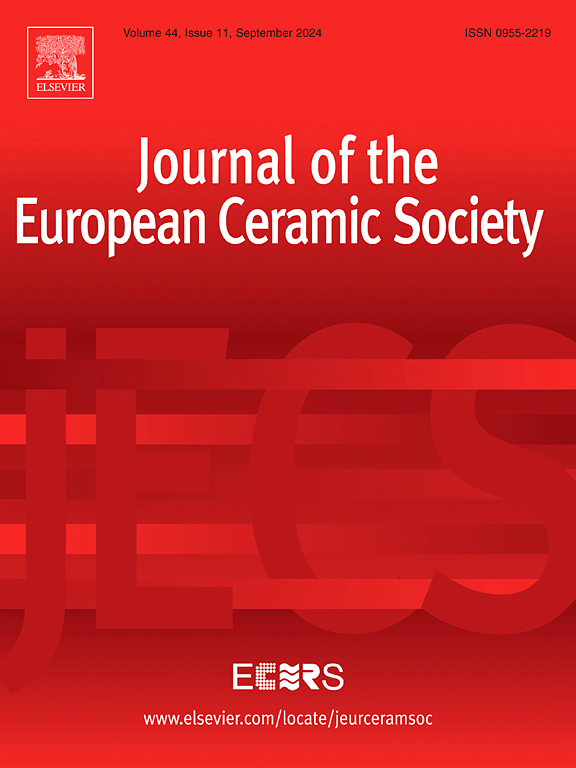High-performance LTCC: Structural and microwave dielectric properties of NaLn(MoO4)2 (Ln = Pr, Sm)
IF 5.8
2区 材料科学
Q1 MATERIALS SCIENCE, CERAMICS
Journal of The European Ceramic Society
Pub Date : 2025-06-10
DOI:10.1016/j.jeurceramsoc.2025.117615
引用次数: 0
Abstract
In this work, the ultra-low loss scheelite-type Na0.5Pr0.5MoO4 and Na0.5Sm0.5MoO4 microwave dielectric ceramics were synthesized via the solid-state reaction method. The sintering behaviors, crystal structures, microstructures, chemical compatibility with silver electrodes, and microwave dielectric properties were systematically investigated. Both compositions exhibit good densification and chemical compatibility with silver electrodes. Na0.5Sm0.5MoO4 ceramic achieves a high Q × f value of 90,900 GHz sintered at 890 °C with = 11.95, and = -45.61 ppm/°C, surpassing Na0.5Pr0.5MoO4 ceramic, which exhibits Q × f = 72,600 GHz sintered at 830 °C. Raman and infrared spectroscopic analyses reveal that low-frequency phonons of [MoO4] tetrahedra dominate the dielectric response. Sm3+ ions improve the packing fraction and structural symmetry of [MoO4] tetrahedra, effectively reducing lattice defects and dielectric losses, which contributes to the superior Q × f value of Na0.5Sm0.5MoO4. These findings highlight the potential of Na0.5Sm0.5MoO4 ceramic as a high-performance candidate for LTCC applications.
高性能LTCC: NaLn(MoO4)2 (Ln = Pr, Sm)的结构和微波介电性能
本论文采用固相反应法制备了超低损耗白长石型Na0.5Pr0.5MoO4和Na0.5Sm0.5MoO4微波介质陶瓷。系统地研究了烧结性能、晶体结构、微观结构、与银电极的化学相容性以及微波介电性能。两种组合物均表现出良好的致密性和与银电极的化学相容性。Na0.5Sm0.5MoO4陶瓷在890 ℃烧结时的Q × f值高达90900 GHz, εr = 11.95, τf = -45.61 ppm/℃,超过了Na0.5Pr0.5MoO4陶瓷在830℃烧结时的Q × f = 72600 GHz。拉曼光谱和红外光谱分析表明,[MoO4]四面体的低频声子主导了介质响应。Sm3+离子提高了[MoO4]四面体的填充率和结构对称性,有效地减少了晶格缺陷和介电损耗,这是Na0.5Sm0.5MoO4具有优越Q × f值的原因。这些发现突出了Na0.5Sm0.5MoO4陶瓷作为LTCC应用的高性能候选材料的潜力。
本文章由计算机程序翻译,如有差异,请以英文原文为准。
求助全文
约1分钟内获得全文
求助全文
来源期刊

Journal of The European Ceramic Society
工程技术-材料科学:硅酸盐
CiteScore
10.70
自引率
12.30%
发文量
863
审稿时长
35 days
期刊介绍:
The Journal of the European Ceramic Society publishes the results of original research and reviews relating to ceramic materials. Papers of either an experimental or theoretical character will be welcomed on a fully international basis. The emphasis is on novel generic science concerning the relationships between processing, microstructure and properties of polycrystalline ceramics consolidated at high temperature. Papers may relate to any of the conventional categories of ceramic: structural, functional, traditional or composite. The central objective is to sustain a high standard of research quality by means of appropriate reviewing procedures.
 求助内容:
求助内容: 应助结果提醒方式:
应助结果提醒方式:


